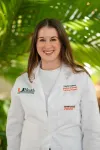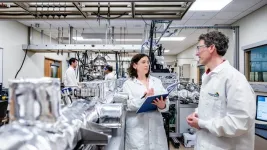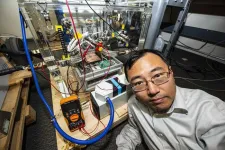The PACE B (Prostate Advances in Comparative Evidence) study found SBRT performed as well as standard treatment with moderately fractionated radiation for people whose prostate cancer had not spread, demonstrating a five-year 96% disease control rate, compared to 95% for conventional radiation.
“The outcomes for patients in both study arms were better than we expected” said principal investigator for the trial Nicholas van As, MD, a consultant clinical oncologist and Medical Director of The Royal Marsden NHS Foundation Trust and a professor at the Institute of Cancer Research in London. “To be able to sit with a patient and say, ‘We can treat you with a low toxicity treatment in five days, and your chance of keeping the cancer at bay for five years is 96%, it’s a positive conversation to have.”
Prostate cancer is one of the most commonly diagnosed cancers in the U.S., second only to skin cancer for male patients. There are approximately 288,300 new cases each year, with rates rising roughly 3% each year since 2014. “As patient volumes rise, substantially reducing the number of times a patient needs to visit a cancer treatment center frees up valuable resources, allowing our radiation oncology teams to treat more patients in less time,” said Prof. van As.
Most prostate cancers are diagnosed before the cancer has grown beyond the prostate gland. The primary treatment options for localized prostate cancer include active surveillance, radiation therapy or surgery to remove the prostate gland.
SBRT is an advanced form of radiation therapy that shrinks or destroys tumors with fewer, higher doses of radiation delivered in a small number of outpatient sessions. This approach uses advanced imaging and treatment planning techniques to deliver radiation with pinpoint accuracy, minimizing damage to surrounding healthy tissue. Patients who choose radiation therapy for intermediate-risk prostate cancer typically receive treatment in 20 daily doses, or fractions, and up to 40, while SBRT is typically given in five or fewer outpatient treatment sessions.
“There’s a lot of evidence now that prostate cancer actually responds better to a large fraction size given over a shorter period of time,” he said. “We’ve demonstrated now that the accelerated course is as effective as the protracted course.”
PACE B was a multi-center, international phase III randomized controlled study to investigate whether SBRT was non-inferior to conventional radiation for treating people with intermediate risk, localized prostate cancer. Non-inferiority was measured by whether patients remained free of biochemical clinical failure (BCF), defined as an increase in PSA levels, distant metastases or other evidence the cancer was returning, or death from prostate cancer.
Drawing from 38 centers across the UK and Canada, PACE B researchers enrolled 874 people who preferred radiation treatment or were unsuitable for surgery. The median age was 69.8 years old.
Patients were randomly assigned to receive either SBRT (n=443) consisting of five fractions over one to two weeks (36.25 Gy total dose), or standard radiation (n=441) consisting of 39 fractions over 7.5 weeks (78 Gy) or 20 fractions over four weeks (62 Gy). None of the patients received hormonal therapy. Median follow-up was 73.1 months.
Five years after treatment, people treated with SBRT had a BCF-event free rate of 95.7% (93.2% - 97.3%), compared to 94.6% (91.9% - 96.4%) for those treated with conventional radiation, demonstrating that SBRT was non-inferior to CRT (90% CI, p-value for non-inferiority=0.007).
Side effects were low in both groups, and not significantly different between treatment arms. At five years post-treatment, 5.5% of patients who received SBRT experienced grade 2 or higher side effects affecting the genital or urinary organs, compared to 3.2% in the conventional group (p=0.14). Only one person in each arm of the study experienced grade 2 or higher gastrointestinal side effects (p=0.99).
“Standard radiation treatment is already highly effective and is very well tolerated in people with localized prostate cancer,” Prof. van As said. “But for a healthcare system and for patients, to have this treatment delivered just as effectively in five days as opposed to four weeks has huge implications.”
Though he expected SBRT to be non-inferior to conventional radiation, Prof. van As said he was surprised at the level of disease control they were able to demonstrate. He attributed the high rates to improvements in image-guidance and technologies to deliver radiation in recent years.
“One of the things this study demonstrated is that outcomes of high-quality radiation therapy are outstanding,” he said. “We’ve become much more precise at tracking and reaching the targets. We’re able to put high doses of radiation in the right place and avoid putting high doses in areas we don’t want it.”
He cautioned the results could not be extrapolated to all people with prostate cancer. “Ninety percent of our patients were intermediate risk, but they were the better end of intermediate risk,” he said. “These results do not apply to people with higher-risk cancer.”
Prof. van As’ team is also examining the use of SBRT for patients with higher-risk disease. The PACE trials (NCT01584258) include three studies investigating the benefits of SBRT for people with localized prostate cancer. PACE A compared patient’s quality of life following SBRT or prostate surgery, finding fewer urinary and sexual side effects from SBRT but a higher risk for minor bowel problems. PACE C, which has completed accrual, investigates how well SBRT works for people with intermediate and high-risk prostate cancer who are also being treated with hormone therapy.
In the meantime, Prof. van As said, people with intermediate risk prostate cancer should be given the option of SBRT as an alternative to longer courses of radiation or prostate surgery.
###
Attribution to the American Society for Radiation Oncology (ASTRO) Annual Meeting is requested in all coverage.
See this study presented:
5-Year Outcomes from PACE B: An International Phase III Randomized Controlled Trial Comparing Stereotactic Body Radiotherapy (SBRT) vs. Conventionally Fractionated or Moderately Hypofractionated External Beam Radiotherapy for Localized Prostate Cancer (LBA 03)
News Briefing: Tuesday, October 3, 9:00 a.m. Pacific time. Details here. Register here.
Scientific Presentation: Plenary session, Monday, October 2, 2023, 2:10 p.m. Pacific time, San Diego Convention Center. Email press@astro.org for access to the live stream or recording.
View the press kit for the 2023 ASTRO Annual Meeting at www.astro.org/annualmeetingpress.
ABOUT ASTRO
The American Society for Radiation Oncology (ASTRO) is the largest radiation oncology society in the world, with nearly 10,000 members who are physicians, nurses, biologists, physicists, radiation therapists, dosimetrists and other health care professionals who specialize in treating patients with radiation therapies. For information on radiation therapy, visit RTAnswers.org. To learn more about ASTRO, visit our website and media center and follow us on social media.
END






